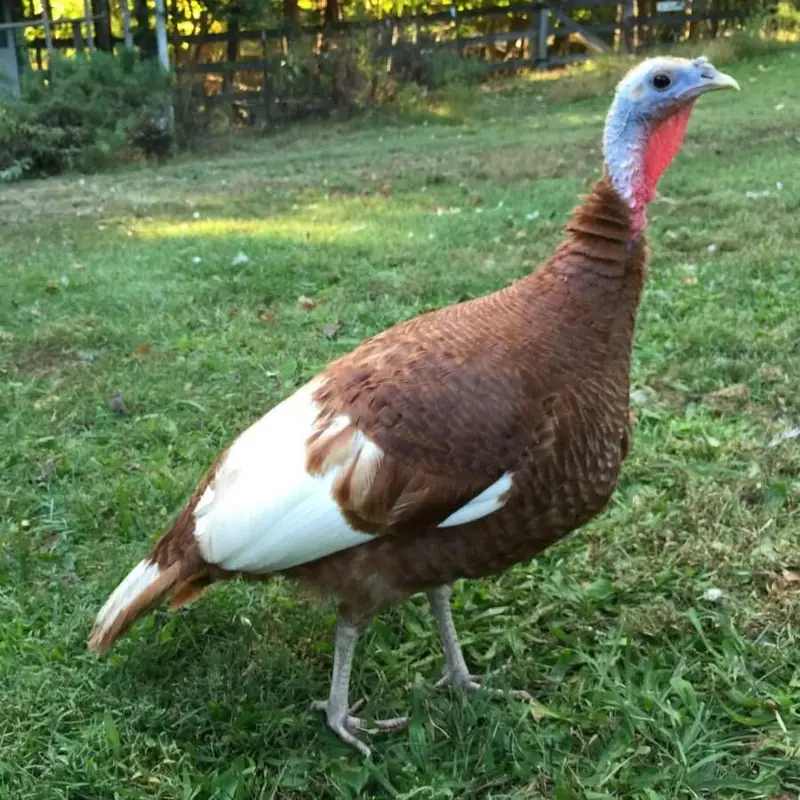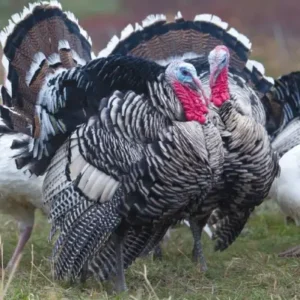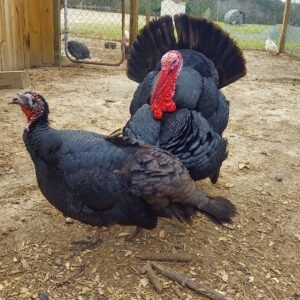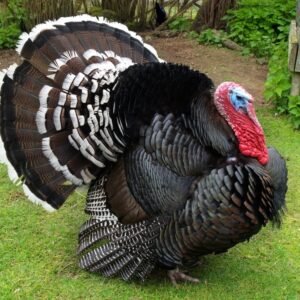$40.00
The Bourbon Red is an American heritage turkey breed developed in Bourbon County, Kentucky, in the late 19th century by J.F. Barbee and others to create a richly colored, medium-sized bird well suited for home flocks and sustainable farming . It features deep chestnut-mahogany body plumage with pure white flight and tail feathers edged in soft red-brown bars, a light-horn beak darkening at the base, pink shanks and toes, and a head and wattle that shift from red to bluish-white when excited . Accepted into the American Poultry Association’s Standard of Perfection in 1909, the Bourbon Red was once an important commercial meat breed before broad-breasted whites came to dominate industrial production . Today it is classified as a heritage turkey by The Livestock Conservancy and listed as “Watch” in the U.S. and “Priority” by the Rare Breeds Survival Trust in the U.K., reflecting both its popularity among small-scale breeders and its need for continued conservation .
Breed History & Recognition
The Bourbon Red traces its roots to Bourbon County, Kentucky, where breeders crossed Buff, White Holland, and Bronze strains to achieve a striking red bird suited to free-range management . Initially known as the Kentucky Red or Bourbon Butternut, it was renamed “Bourbon Red” upon acceptance into the APA’s Standard of Perfection in 1909 . In the early 20th century it became a favored commercial turkey, prized for its moderate size and flavor, but declined sharply as the Broad Breasted White rose to industrial prominence . Conservation efforts by The Livestock Conservancy and heritage poultry organizations have since revived interest, leading to a stable but still watch-listed population in the U.S. .
Physical Characteristics
- Plumage: Rich chestnut-mahogany body feathers with white primary and tail feathers; many birds show darker edging or faint red-brown bars on tail tips .
- Head & Wattle: Bright red at rest, shifting to bluish-white flush during courtship or excitement .
- Beak & Eyes: Beak light horn at the tip, darkening toward the base; eyes dark brown .
- Skin, Shanks & Toes: White skin; shanks and toes pink, sometimes deepening in hue in young birds .
- Beard: Black, typical of heritage turkeys .
Size & Growth
- Young Market Weights: Toms average 23–25 lb; hens 14–15 lb when processed at 12–16 weeks .
- Mature Weights: Ideal adult toms reach 32 lb and hens 18 lb under APA standards, though many heritage flocks fall slightly below due to limited selection for size .
- Growth Rate: Slow-growing, maturing around 28 weeks, which contributes to superior meat texture and flavor .
Temperament & Foraging
Bourbon Reds are active foragers, well adapted to pasture-based systems, and generally exhibit hardy constitutions . Depending on breeder lines, they range from docile and people-friendly to more assertive, especially toms competing for mates . Their moderate size and natural mating ability make them ideal for small farms and homesteads .
Reproduction & Eggs
- Egg Production: Hens lay 20–50 large, pale cream to mid-brown speckled eggs per year .
- Setters & Fertility: Good broodiness and fertility rates around 60–75%; poults generally hardy when raised naturally .
- Breeding Ratio: Recommended ratio of 7–10 hens per tom for optimal fertility .
Culinary Qualities
Bourbon Reds are prized for their rich, fine-textured dark meat and moderate, tender white meat, offering a more authentic turkey flavor than industrial strains . Their pale pin feathers also ensure clean-looking carcasses, making them a favorite among chefs and heritage food enthusiasts .
Conservation & Availability
Although more numerous than some critically endangered breeds, the Bourbon Red remains on “Watch” status in the U.S. and “Priority” in the U.K., with availability limited to heritage hatcheries and dedicated breeders . Renewed interest in pastured poultry, farm-to-table dining, and genetic diversity has fostered modest population growth, but continued breeding programs and consumer support are vital for long-term preservation
Be the first to review “Bourbon Red Turkey” Cancel reply
Related products
Turkeys
Turkeys
Turkeys
Turkeys






Reviews
There are no reviews yet.